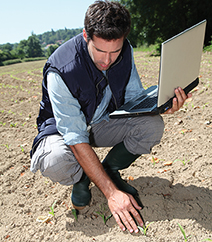Welcome to Blue Book!
Are you ready to join the thousands of companies who rely on Blue Book to drive smarter decisions? View our plans and get started today!
Still have questions? We’d love to show you what Blue Book can do for you. Drop us a line– we’ve been waiting for you.

The human cost in California’s Central Valley, however, has been devastating with a million-plus acres of fallowed farmland, 21,000 lost jobs, and economic losses as high as $2.7 billion and rising.
“Restoring practicality and balance to the way environmental policies are imple-mented,” asserts Puglia, “will be to the benefit of everyone in the industry, across the supply chain.”
Where There’s A Will, There’s A Way?
When faced with adversity, American agriculture has risen to the challenge time and time again, innovating through technology and creating solutions. Since 1967, applied water in California agriculture has decreased 14.5 percent, while the California Farm Water Coalition says crop production per acre-foot of water has increased 85.4 percent.Solving these challenges might seem like an insurmountable task, but with a world of possibilities the only real limit might be our imagination. With many fruits and vegetables themselves comprised of 90 percent water or more, the industry continues to invest in new solutions to capitalize on this important element, such as genetic engineering to breed more water-efficient cultivars, and ways to strengthen plant DNA against moisture loss, pests, and disease.
Mike Stuart, president of the Florida Fruit & Vegetable Association believes technology “is critically important to the future of our industry. Tremendous strides have been made in disease resistance through genetic modification, and research for drought traits has significant possibilities.”
Taking more control of growing environments through use of drip irrigation and hydroponic greenhouses continues to increase water efficiency efforts with the bonus of improving yields. But there is still much to be accomplished, both in the field and through protected agriculture. “Drip irrigation is not as prevalent in Texas as you would hope,” observes Bret Erickson, president of the Texas International Produce Association. “It’s estimated we lose about 50 percent of water in the delivery process.”
Capturing more of the rain that does fall is another option. Ag Innovations Network, working with the California Agricultural Water Stewardship Initiative in Bodega Valley, successfully piloted several community rainwater catchment systems. The project included a pioneering 235,000-gallon underground storage system, and roof water harvesting system designed to collect 1.4 million gallons. The water was then stored in a pond with a floating cover to reduce evaporation loss and help maintain water quality.
There have also been improvements in desalination. The Claude ‘Bud’ Lewis Carlsbad Desalination Plant, which serves San Diego residents, was recently lauded for its water treatment success and environmental achievements by the Global Water Intelligence group. And while this and other endeavors represent progress, they are not yet—either separate or combined—a viable solution to California’s water woes.
Congressman Devin Nunes, representing California’s Central Valley, agrees. “Reforming federal laws that restrict the use of our water infrastructure is the critical first step in overcoming this crisis.”
Few understand this need for reform more than Golden State growers. Every day the law goes unchanged, Californians lose an estimated 2 billion gallons of water to the ocean to comply with environmental policies protecting endangered fish. From December 2015 to late February 2016, 184 billion gallons of California water were flushed out to sea—enough water to produce 9 billion salads according to the California Farm Water Coalition.




